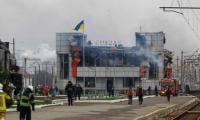The writer is a development specialist with expertise in parliamentary oversight and sustainable development.
During last month’s Saarc teleconference, regional stakeholders stressed the need to fast-track knowledge-sharing on Covid-19. The same month, the World Bank assessed that South Asia would be worst hit by the economic crunch due to the pandemic, with inflation expected to average at 11.8 percent in 2020.
South Asia is home to 627 million children (under the age of 18) that constitute almost 36 percent of the global child population of 1.82 billion. According to World Bank estimates, our region has the second highest share of children living in extreme poverty at nearly 36 percent. Four out of five children in extreme poverty live in rural areas resulting in Constitutional Growth Delays (CGD) and one of the world’s highest child mortality rates in this region.
Simply put, poverty means lack of access to adequate resources, including clean drinking water and healthcare facilities. This in turn means nutrition challenges and morbidity among children. Early malnutrition in a child increases the risk of under-five mortality; alongside lifelong consequences, such as failure to thrive, cognitive deficiencies, poor economics and weak social outcomes. According to the World Health Organization (WHO), globally in 2017, 30 percent of deaths under the age of five occurred in South Asia. Indicators in South Asia show half of the world’s high stunting prevalence, a key driver for wasting in children due to acute nutritional deficiency.
Deprivation profiles on social identities like poverty line, ethnicity and caste show that children born in poor households living in rural areas have higher risks of being born stunted. Similarly, children born to uneducated, economically weak, malnourished, and/or underage girls are more susceptible to be stunted.
Globally, there are 23 million partially immunized children and eight million of them live in South Asia. South Asia remains the last region still fighting the poliovirus. Inequalities remain, both in terms of immunization coverage and access to vaccines within countries. The determinants of slow progress are poor healthcare systems, inaccessible geographical terrain, environmental considerations, cultural misconceptions and weak social service governance.
Studies show that vaccination is the most cost-effective intervention, with high return on investment for every dollar spent on immunizing a child. There are 610 million people practising open defecation in South Asia (over 60 percent of the global burden). Poor sanitation and hygiene behaviours, and over 119 million people with no access to safe drinking water results in over 177,000 children dying annually due to diarrhoea.
South Asia is home to over 62 million stunted children out of 155 million globally. Poor mother-child conditions in South Asia are associated with inter-generational consequences to health & nutrition, education, social upbringing and earnings. Symptoms of malnutrition are invisible until permanent damage is done; child wasting amid low weight to height ratio and susceptible to infectious disease. Impaired brain development (smaller, and less dense), mental retardation with severe impact on motor skills results in poor learning outcomes at school.
According to Unicef estimates, stunted growth in children can lead to 45 percent losses in lifetime earnings of an individual with intergenerational consequences. Widening education gaps due to poor cognitive behaviour and high school dropout ratio have a direct impact on economic productivity and human capital. According to McKinsey analysis, every dollar spent on early childhood development can lead upto to $8 economic returns. Preventing stunting challenges in one child can deliver over $580 per individual.
Given the ongoing pandemic, children are most neglected and highly vulnerable. Drawing parallels with previous health emergencies, the world witnessed that children are at high risk of exploitation, abuse and violence especially when schools are closed, social services disrupted and restricted regional movement. During the Ebola outbreak in West Africa from 2014-16, school closures and restricted movement resulted in record high child labour, sexual abuse, rape and teenage pregnancies.
Today, learning opportunities for over 430 million children have been disrupted due to school closures across South Asia. It is highly likely that the region will witness exponential increase in child labour as soon as the lockdown is eased. South Asia is home to 41 million children directly employed as child labour, predominantly 10.3 million between the 5 and 14 years age bracket. According to ILO estimates, over 71 percent of children are employed in the agriculture-related economy worldwide. Given South Asia’s dependence on agriculture, with food supply chains disrupted and market accessibility hampered, the risk of children being absorbed into the labour workforce is manifold.
The Covid-19 outbreak has all the ingredients to leave unprecedented challenges for children of South Asia. The pandemic has overwhelmed already fragile health systems and undermined many of the gains made in child survival, health, nutrition and development over the last many decades. With poliovirus vaccination campaigns halted, progress to exterminate the virus in its last two strongholds has been disrupted: 137 cases in Pakistan and 28 in Afghanistan. However, this ordeal continues due to mismanaged public health priorities, conflict zone, and hotbed of militants targeting vaccination teams along the border.
Economic modeling estimates prove that a world free of the poliovirus could save up to $50 billion for low-income countries like Afghanistan and Pakistan. In addition to Covid-19, there are other threats of outbreaks, eg measles. Twenty-four countries have already suspended measles immunization campaigns targeting nearly 80 million children which is expected to increase to 37 countries while putting 117 million children at risk. These alarming figures are certainly to proliferate; given that these figures do not account for disrupted services due to the current pandemic.
While governments in South Asia have introduced alternative online learning programmes, the fact remains that internet penetration rate remains low – average of 15 percent across the region. With no or limited offline education solutions, girls are more likely to not return to schools once education institutions resume. In South Asia, Pakistan has the highest girls to boys drop out ratio at 41.1 percent, followed by Nepal at 40 percent. Those who were previously removed from child labour are now at heightened risk of relapsing. Financial shocks experienced by economically marginalized households can lead to genetic intergenerational poverty, sets in motion chronic illness, potential disability and genetic influence.
Given the catastrophic economic consequences of Covid-19, “there could be hundreds of thousands of additional child deaths in 2020”, UN Secretary-General Antonio Guterres has warned. This scenario would effectively reverse snail-paced progress made in reducing infant mortality over the decades in South Asia.
Despite efforts, modest change is witnessed in some countries. India and Bangladesh have shown a nominal one percent decline in stunting while that of Pakistan and Sri Lanka has remained unaltered. A large body of evidence proves that multi-sectoral intervention in child health such as national immunization programmes and nutrition scale-up result in promising demographic dividends. This results in improved school attainment indicators along with positive impact on cognitive function – only to grow into healthier adults.
The economic performance of the region has been marred by (inter and intra-state) security challenges, internal displacements and refugee burden. All this has shifted priorities by reallocation of resources from development to traditional security and disaster management. To catalyze what the Saarc health ministers meeting joint communique set to establish a Covid-19 Emergency Relief Fund, real-time information-sharing, research, development and innovation must be the centerpiece of this multilateral cooperation.
While statistical disparities exist across South Asia, alarming figures on child social development reflect that public investment must be re-oriented. Child anthropometrics must be translated into serious interventions on poverty transmission reduction, health outcomes and high-quality surveillance systems to safeguard future productive generations.
While a regional coordinated response to Covid-19 is essential, the greatest test for the current South Asian generation is to protect future generations through a shared vision of recovery. Redoubling efforts to ensure child growth in the poorest of households is key to regain any lost ground as a result of the Covid-19 pandemic, and to build equitable development for all. Radical and forceful interventions, targeted debt relief, and progressive tax reforms are essential for a South Asian peace dream. But, more importantly, the need for a paradigm shift towards sustainable human security is inevitable like never before.
Twitter: @HassanHakeem87















